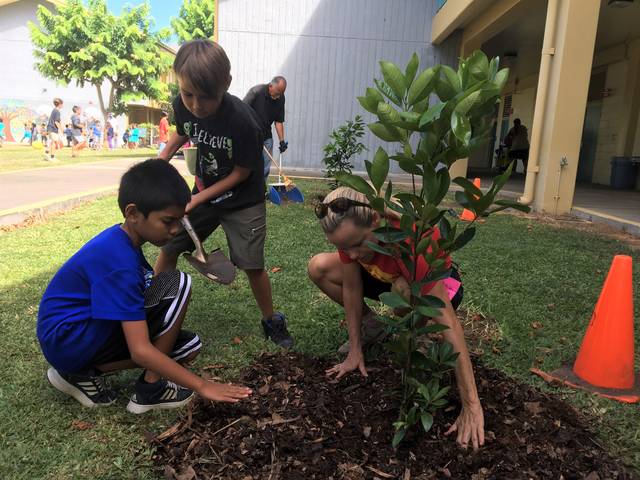KAILUA-KONA — Long after Brandon Curry and Sei Smith finish their last day at Kahakai Elementary School, the trees they and their peers planted at the campus Tuesday will continue to bear fruit, giving the students who come after them a source of food and learning.
“It’s really fun,” said Curry, 11. “You get to enjoy nature and to help out kids that need food and, especially the school lunches, how they would have fresh food.”
Smith, 11, agreed.
“It’s important, because it helps the environment,” he said, “it makes school lunches better.”
The two students were among roughly 120 Kahakai Elementary School fifth graders who took part in the planting of 21 trees at the campus with the help of The Fruit Tree Planting Foundation, a nonprofit focused on bringing fruit trees to anywhere they can best serve a community.
“We believe that planting fruit trees is one of the most elegant solutions to so many of the world’s problems,” said Cem Akin, co-creator and “tree-E-O” of the foundation. “We can do all of these things by just planting a fruit tree — we can alleviate global hunger, mitigate climate change and bring communities together.”
The foundation is headquartered in Pittsburgh with branches around the world, including lower Puna.
By the time they’re finished, the foundation will have helped communities on the island plant 190 fruit trees at seven sites, six of them schools, said program manager Lizzy Rainey. Seventy-one of the trees are being planted in Kona — including 40 at Kealakehe Intermediate School on Monday as well as 21 at Kahakai Elementary School and 10 at Kona Pacific Public Charter School Tuesday.
And for Kahakai Elementary School vice principal Nia Lovell, the impact of Tuesday’s planting will, she hopes, extend beyond the schoolyard.
“Part of it that we want to do is to give food back to our community and our families,” she said.
After the appearance of holes on the grounds over the last weekend prompted questions from students, she said, she spoke with one student about the fruit trees that would soon fill them.
“And this little boy’s face just lit up,” she said, “and he just said, ‘Wow, fruit is really awesome, and we’re actually going to be able to eat fruit from our school, and I can actually take it home and have food.’”
“And it just brought tears to my eyes,” Lovell continued, “because that’s about giving back to our community and to our kids — not just for now, but in 10, 15 and 20 years, when I’m no longer here, that these trees are going to continue to give.”
Among the trees being planted at the schools are citrus trees, avocados, ulu and more. Akin credited the William J. and Dorothy K. O’Neill Foundation and Herb Joseph of Lower Puna for making the local plantings possible.
Rainey said in choosing which trees to plant the foundation looks to the teachers and staff.
“We really want to make sure that the trees that we supply are something that’s in-demand by the school, they think the kids will eat, they have a use for it,” she said.
Along with the important work of learning to plant the trees, the students also learned about the need to continue caring for the trees in the future and what they can offer people and the environment if they’re well taken care of.
“We want you to be stewards or guardians of the environment,” Hector Montenegro, who consults with the foundation, told the students before the planting. “And that’s very important that you learn how to plant trees, how to take care of them, how to water them.”
Rainey said they also want students to remember their experience.
“We want them to take care of these trees and feel a connection to them,” she said. “We hope that they can understand that this is where that delicious fruit comes from; it’s not packaged and wrapped in a supermarket. It comes from a tree that starts off small like this and can grow and grow past even sometimes their own lifetimes.”
Smith said he hopes the students who follow them continue to take ownership of what they planted.
“I hope they care for them well, water them,” he said.
He and Curry also noted how they hope their school makes the trees a part of the community for years to come.
“It kind of brings our family and friends all together,” said Curry.
The trees’ value extends beyond the nutrition they can provide, Lovell noted, saying that teachers and students of all subjects — from art to science to writing and more — can find value in the trees’ presence on the campus.
“This isn’t just about planting a tree and putting it into the ground,” she said, “it’s about infusing music, art, science and chemistry and pH and lots of things. So it’s about incorporating all of what we’re doing in school through trees.”



